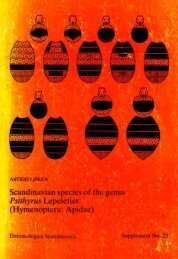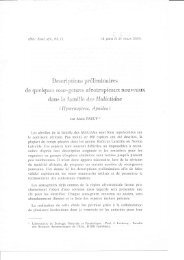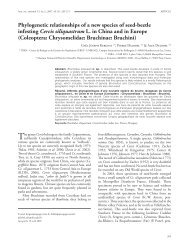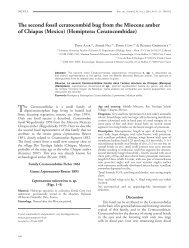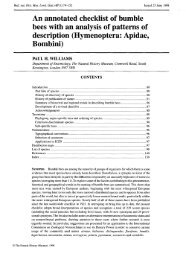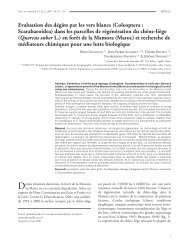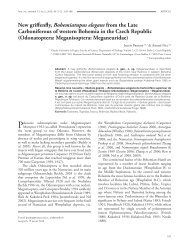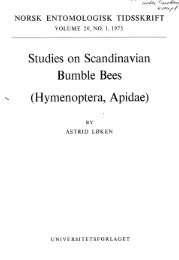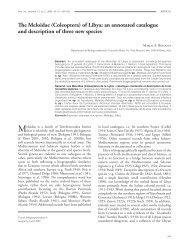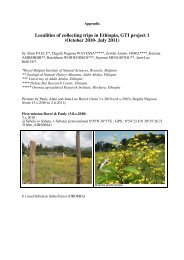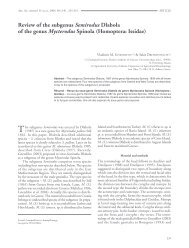Première approche de la méliponiculture et des mélipones de Guyane
Première approche de la méliponiculture et des mélipones de Guyane
Première approche de la méliponiculture et des mélipones de Guyane
- No tags were found...
You also want an ePaper? Increase the reach of your titles
YUMPU automatically turns print PDFs into web optimized ePapers that Google loves.
Silva D. L. N. da1977 - Estudos bionomicos em colônias mistas <strong>de</strong> Meliponinae.Bol. Zool. Saõ Paulo, 2 : 7-106.Silva G. F. da, Venturieri G. C. & Silva E. S. A.? - Meliponiculture as a sustainable <strong>de</strong>velopment alternative: financial management within familygroups in northeast Amazon, Brazil.12 pp.Silveira F. A., Melo G. A. R. & Almeida E. A. B.2002 - Abelhas Brasileiras: Sistemática e I<strong>de</strong>ntificação.Belo Horizonte, MG, Min, Meio Ambiente/fund, Araraucária, 253 pp.Silvera F. A., Pinheiro-Machado C., Alves dos Santos I., Kleinert A. M. P. & Imperatriz-Fonseca V.L.2002 - Taxonomic constraints for the conservation and sustainable use of wild pollinators - TheBrazilian wild bees.In : Kevan P. G. & Imperatriz-Fonseca V. L. (eds), Pollinating bees, The conservation linkb<strong>et</strong>ween agricultureand nature, Ministry of environement, Brazilia, 41-50.S<strong>la</strong>a E. J.2003 - Foraging ecology of stingless bees: from individual behaviour to community ecology.Elinkwijk, Utrecht, The N<strong>et</strong>her<strong>la</strong>nds.S<strong>la</strong>a E. J., Nieuwstadt M. G. L., Pisa L. W. & Sommeijer M.J.1997 - Foraging strategies of stingless bees (Apidae, Meliponinae): The re<strong>la</strong>tion b<strong>et</strong>ween precision ofrecruitment, comp<strong>et</strong>ition and communication.Acta Horticulturae, 437 : 193-197.S<strong>la</strong>a E.J., Wassenberg J., Biesmeijer J.C.2003 - The use of field-based information in eusocial foragers: local enhancement among nestmatesand h<strong>et</strong>erospecifics in stingless bees.Ecological Entomology, 28 : 369-379.Smith F.1863 - Descriptions of Brazilian honey bees, belonging of the genera Melipona and Trigona.Transactions of the Entomological Soci<strong>et</strong>y of London, 11 : 497–512.Sodré G. da S., Carvalho C. A. L. <strong>de</strong>, Alves R. M. <strong>de</strong> O., Fonseca A. A. O.2009 - Desumidificação do mel <strong>de</strong> abelhas sem ferrão.Magistra, 21 : 41-43.Sommeijer M. J.1984 - Distribution of <strong>la</strong>bour among workers of Melipona favosa F.: age-poly<strong>et</strong>hism and workeroviposition.Insectes Sociaux, 31 (2) : 171-184.1985 - The social behavior of Melipona favosa (F): some aspects of the activity of the queen in the nest.Journal of the Kansas Entomological Soci<strong>et</strong>y, 58 (3) : 386-396.1999 - Beekeeping with stingless bees: a new type of hive.Bee World, 90 (2) : 70-79.<strong>Première</strong> <strong>approche</strong> <strong>de</strong> <strong>la</strong> <strong>méliponiculture</strong> <strong>et</strong> <strong>de</strong>s <strong>mélipones</strong> <strong>de</strong> <strong>Guyane</strong> / Programme Oyana – 2011 – Cronosservices Page 94 sur 123



